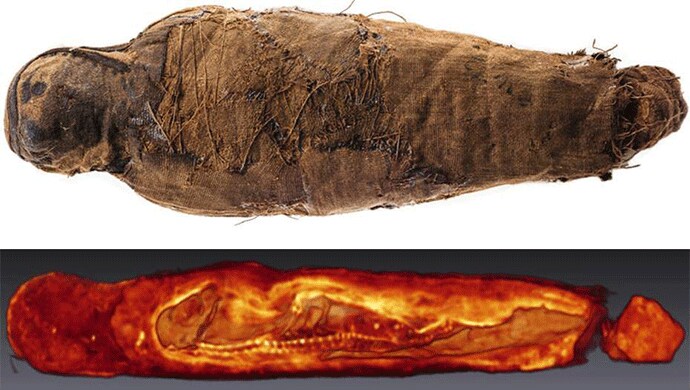Search
The Oriental Institute of the University of Chicago uses Amira software to visualize and analyze Egyptian mummified birds
Customer Spotlight
By Rozenn Bailleul-LeSuer, The University of Chicago, Department of Near Eastern Languages and Civilizations
Entering this special exhibit at the Oriental Institute Museum at the University of Chicago, you will immediately feel transported into the ancient Nile delta marshlands with its lush green flora.
The combination of colors, video footage, bird songs, and ancient artifacts will give you the impression that you have just traveled through time and space.
At the start of the exhibit, you will find one of their most impressive artifacts, an empty shell of an ostrich egg from 3100 B.C. With its perfect shape and marbleized shell, it appears as if it has just been carved out of stone. These ostrich eggs have not only been used in ancient Egypt as containers for liquids and raw material for bead carving, but also symbolize the deep integration of avian life into ancient Egypt's spirituality. All life is at times described as entering and leaving the world through the egg as a vessel, and that birds are messengers that can travel between the realms of men and their gods. Many of the Egyptian gods are portrayed as birds, and even their people have been symbolized by different bird species.
Such information about ancient cultures has been extracted from many sources such as ancient texts and drawings, exploration of burial sites, and with the help of X-ray CT imaging from mummified bird specimens. As shown impressively by Rozenn Bailleul-LeSuer, the reconstructed 3D X-ray images can be examined with Amira software to extract the desired information and sometimes even discover surprises. Rozenn and her team of imaging scientists worked on several specimens, of which we would like to highlight two. Information about the remaining specimens and artifacts exhibited at the Oriental Institute can be found in the catalogue that complements this exhibit.
The most impressive imaging results were obtained from a small falcon, which is unfortunately not on display at the exhibit due to space limitations. It is shown here in figure 1 and highlighted in the exhibits catalogue in chapter 13: "Challenges in CT Scanning of Avian Mummies". The falcon's size and its missing wrappings allowed this specimen to be imaged in a micro-CT system at a resolution of approximately 180μm; more than 40x higher than the clinical imaging system used for larger specimens.

Using Amira software's advanced segmentation functionality and volume rendering, which allows masking of segmented regions in the visualization, the exact species of the falcon could be determined. Furthermore, it was shown that its neck had been severed, but that internal organs were still intact. The intestines had been pushed to the posterior of the bird to make room for a filled gizzard. The images also revealed the contents of the gizzard, which was identified as the remains of a small rodent from a piece of intact jaw bone.
CT images from another mummy revealed a small juvenile Eurasian sparrowhawk (figure 2). In this mummy, the wrappings were larger than required for a bird of this size. Missing bone calcification was evidence for the immaturity of the bird, and a posterior air pocket indicated penetration of insects that fed on the bird's carcass. With this specimen, careful segmentation in Amira software was the essential key for visualization of the mummy's interior and identification of the bird. Here, the low calcification proved challenging during the segmentation process. Once the segmentation was completed, Amira software's crisp surface rendering allowed further analysis and identification.
"Between Heaven & Earth: Birds in Ancient Egypt" is an exciting exhibit combining traditional archeological and anthropological methods with modern imaging techniques to inform the interested visitor about the role of birds in routine daily life as well as spirituality of ancient Egypt.The Oriental Institute is open to the public without an admission fee. Additional information about this exhibit can be found at: http://oi.uchicago.edu/museum/special/ birds/ . Special thanks go to Gil Stein, Jack Green, Laura d'Alessandro and Alison Whyte of the Oriental Institute for granting access to the mummified birds and preparing them for CT imaging.

Figure 2: A mummified juvenile sparrowhawk in its too large wrapping.he size of the mummy required image acquisition in a clinical CT, resulting in visualization of only coarse details. In addition the low bone calcification further reduces bone contrast.
The Oriental Institute is a research organization and museum devoted to the study of the ancient Near East. Founded in 1919 by James Henry Breasted, the Institute, a part of the University of Chicago, is an internationally recognized pioneer in the archaeology, philology, and history of early Near Eastern civilizations.
About Amira & Avizo 3D Software
Amira and Avizo are high-performance 3D software for visualizing, analyzing, and understanding scientific and industrial data coming from all types of sources and modalities.
Courtesy: Mummies photographed by Anna R. Ressman. All photos and images © Oriental Institute at the University of Chicago